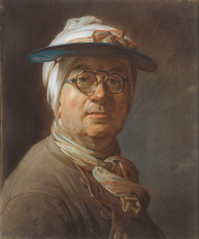Difference between revisions of "Portrait"
(Created page with 'File:lighterstill.jpgright|frame ==Origin== Middle French, from past participle of ''portraire'' *[http://en.wikipedia.org/wiki/16th_centu...') |
m (Text replacement - "http://" to "https://") |
||
| Line 3: | Line 3: | ||
==Origin== | ==Origin== | ||
Middle French, from past participle of ''portraire'' | Middle French, from past participle of ''portraire'' | ||
| − | *[ | + | *[https://en.wikipedia.org/wiki/16th_century 1570] |
==Definitions== | ==Definitions== | ||
*1: [[picture]]; especially : a pictorial [[representation]] of a [[person]] usually showing the [[face]] | *1: [[picture]]; especially : a pictorial [[representation]] of a [[person]] usually showing the [[face]] | ||
| Line 11: | Line 11: | ||
A '''portrait''' is a [[painting]], photograph, [[sculpture]], or other artistic [[representation]] of a person, in which the [[face]] and its [[expression]] is predominant. The [[intent]] is to display the likeness, [[personality]], and even the [[mood]] of the person. For this reason, in photography a portrait is generally not a snapshot, but a composed image of a person in a still position. A portrait often shows a person looking directly at the painter or photographer, in order to most successfully [[engage]] the subject with the viewer. | A '''portrait''' is a [[painting]], photograph, [[sculpture]], or other artistic [[representation]] of a person, in which the [[face]] and its [[expression]] is predominant. The [[intent]] is to display the likeness, [[personality]], and even the [[mood]] of the person. For this reason, in photography a portrait is generally not a snapshot, but a composed image of a person in a still position. A portrait often shows a person looking directly at the painter or photographer, in order to most successfully [[engage]] the subject with the viewer. | ||
| − | When the artist creates a ''portrait'' of him- or herself, it is called a [[self]]-portrait. Identifiable examples become numerous in the late Middle Ages, but if the definition is extended the first was by the Egyptian Pharaoh [ | + | When the artist creates a ''portrait'' of him- or herself, it is called a [[self]]-portrait. Identifiable examples become numerous in the late Middle Ages, but if the definition is extended the first was by the Egyptian Pharaoh [https://en.wikipedia.org/wiki/Akhenaten Akhenaten]'s sculptor Bak, who carved a representation of himself and his [[wife]] Taheri c. 1365 BC. However, it seems likely that self-portraits go back to the [https://en.wikipedia.org/wiki/Cave_paintings cave paintings], the earliest representational art, and literature records several classical examples that are now lost. |
| − | In [[literature]] the term ''portrait'' refers to a [[written]] [[description]] or [[analysis]] of a person or thing. A written portrait often gives deep [[insight]], and offers an analysis that goes far beyond the [[superficial]]. For example, American author [ | + | In [[literature]] the term ''portrait'' refers to a [[written]] [[description]] or [[analysis]] of a person or thing. A written portrait often gives deep [[insight]], and offers an analysis that goes far beyond the [[superficial]]. For example, American author [https://en.wikipedia.org/wiki/Patricia_Cornwell Patricia Cornwell] wrote a best-selling book titled ''[https://en.wikipedia.org/wiki/Portrait_of_a_Killer Portrait of a Killer]'' about the personality, background, and possible [[motivations]] of [https://en.wikipedia.org/wiki/Jack_the_Ripper Jack the Ripper], as well as the [[media]] coverage of his [[murders]], and the subsequent police [[investigation]] of his [[crimes]]. |
[[Category: The Arts]] | [[Category: The Arts]] | ||
[[Category: Languages and Literature]] | [[Category: Languages and Literature]] | ||
Latest revision as of 01:49, 13 December 2020
Origin
Middle French, from past participle of portraire
Definitions
- 1: picture; especially : a pictorial representation of a person usually showing the face
- 2: a sculptured figure : bust
- 3: a graphic portrayal in words
Description
A portrait is a painting, photograph, sculpture, or other artistic representation of a person, in which the face and its expression is predominant. The intent is to display the likeness, personality, and even the mood of the person. For this reason, in photography a portrait is generally not a snapshot, but a composed image of a person in a still position. A portrait often shows a person looking directly at the painter or photographer, in order to most successfully engage the subject with the viewer.
When the artist creates a portrait of him- or herself, it is called a self-portrait. Identifiable examples become numerous in the late Middle Ages, but if the definition is extended the first was by the Egyptian Pharaoh Akhenaten's sculptor Bak, who carved a representation of himself and his wife Taheri c. 1365 BC. However, it seems likely that self-portraits go back to the cave paintings, the earliest representational art, and literature records several classical examples that are now lost.
In literature the term portrait refers to a written description or analysis of a person or thing. A written portrait often gives deep insight, and offers an analysis that goes far beyond the superficial. For example, American author Patricia Cornwell wrote a best-selling book titled Portrait of a Killer about the personality, background, and possible motivations of Jack the Ripper, as well as the media coverage of his murders, and the subsequent police investigation of his crimes.
